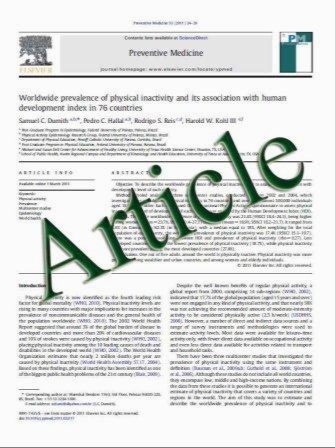Optimal cutoff values of waist circumference and the discriminatory performance of other anthropometric indices to detect the clustering of cardiovascular risk factors for metabolic syndrome in Japanese men and women
- نوع فایل : کتاب
- زبان : انگلیسی
- مؤلف : Kazuyo Nakamura Hinako Nanri Megumi Hara Yasuki Higaki Takeshi Imaizumi Naoto Taguchi Tatsuhiko Sakamoto Mikako Horita Koichi Shinchi
- چاپ و سال / کشور: 2010
Description
Objective To evaluate the pertinent cutoffs of waist circumference (WC) and the discriminatory performance of other anthropometric indices to detect clustering cardiovascular risk factors for metabolic syndrome (MetS) in Japan, where the current WC cutoffs for MetS (85 cm for men and 90 cm for women) remain controversial. Methods We analyzed the baseline data from 844 subjects (330 men and 514 women) aged 40–69 years who participated in a cohort study in Saga city, Japan, between November 2005 and December 2007. Receiver operating characteristic (ROC) analyses were performed to find an appropriate cutoff (defined as the point nearest to the upper left corner of the ROC curve) of each anthropometric index for the presence of multiple risk factors among dyslipidemia, hypertension, and hyperglycemia [which was defined as hemoglobin A1c (HbA1c) levels at and above 5.2, 5.5, or 5.8%, values approximately corresponding to fasting plasma glucose levels of 100, 110, and 120 mg/dL, respectively]. Results The optimal WC cutoff was 88 cm (sensitivity 60%, specificity 70%) for men and 82 cm (sensitivity 78%, specificity 62%) for women; changing the HbA1c cutoff affected the results in women only (*85 cm). For the currently defined WC cutoffs in Japan, specificity was low (53–57%) in men, whereas sensitivity was very low (32–42%) in women. Body mass index, proportion of body fat, waist-to-height ratio, and waist-to-hip ratio showed area under the curve values similar to that of WC. Conclusion The current Japanese criteria of WC for MetS may be low for men and too high and insensitive for women in our study population. Other anthropometric indices such as waist-to-height ratio did not confer an improved discriminatory performance compared with WC.
Environ Health Prev Med (2011) 16:52–60 DOI 10.1007/s12199-010-0165-y Received: 4 March 2010 / Accepted: 6 July 2010 / Published online: 30 July 2010


